
Featured Blog | This community-written post highlights the best of what the game industry has to offer. Read more like it on the Game Developer Blogs or learn how to Submit Your Own Blog Post
Breaking Down Supercell's Next Hit: Clash Royale
This is a comprehensive analysis of Supercell's latest title, Clash Royale. I examine the product from a holistic perspective and breakdown core innovative elements to learn from.



Foreword
You may or may not be aware, but Supercell has a frequent soft launch, test, and kill approach when it comes to developing games. They are pretty selective with most games either not making soft launch or by being quietly removed from the app store without much of a word. Recently however, a new Clash spin-off has been gaining massive momentum.
The game: Clash Royale
While Clash Royale is very early in its life span, it is looking to be a promising product. The game has reached in the top 5 grossing in Canada (its initial soft launch territory) and has overwhelmingly positive predictive numbers from 3rd party services. It seems like a great time to research and analyze what looks to be Supercell’s next big block busting title.
So without wasting any more of your time, let’s chat Clash Royale.
Leveraging the Clash Brand
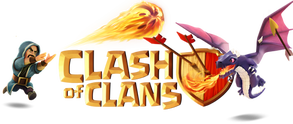

With the cost of user acquisition rising significantly, obtaining a known brand for your mobile game is becoming more and more crucial to gaining early success. Lucky for Supercell, they own a small title you might have heard of, Clash of Clans.
Clash of Clans, is an absolute mega-nuclear hit with well over 300 million installs and revenues reaching over 2.5 billion worldwide (yes, you read that right…). It has however been reaching a slow critical mass over the last year with install numbers trending on a subtle decline. It makes sense for Supercell to start funneling its literal millions of players onto a new product or more ideally, both.
Enter Clash Royale, a game designed using the mighty power of the Clash of Clans brand. The visuals and themes are the same. Mechanics are familiar, and the game has been designed with a strikingly similar demographic in mind.
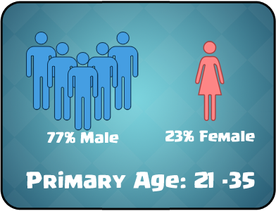

At even the simplest glance it becomes obvious Supercell is aiming to recoup and retain their player base from Clash Royale’s big brother. The similarities don’t stop here however, a lot of the same design fundamentals have also been followed.
Simple and Scalable Design
At its core, Clash Royale gameplay is elegantly simple; it is a CCG meets real-time tower defense. The gameplay and systems design takes a real MVP, or more importantly Minimum Awesome Product approach. This design fundamental makes the creation, implementation, and iteration rapid and easily achievable with a relatively small development team. The gameplay itself is easy to learn but impossible to master; and strikes that midcore sweet-spot that Supercell has mastered over the years.
The core loop resembles something like below:
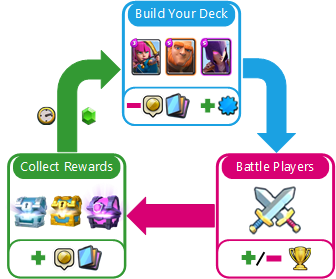

 Combat
Combat

Players automatically match make against each other.
Combat is real-time PVP.
Two players face off across a field with 3 buildings (2 Arena Towers and a King’s Tower)
Buildings attack enemy troops within range
Arena Towers are worth 1 star each, the King’s Tower is worth 3.
Each player has an Elixir resource that generates over time to a cap of 10.
Players get 4 cards they can play from a deck which was assembled before the game.
Decks have 8 total cards.
Cards cost varying amounts of Elixir and once played are removed and replaced.
The game ends when either the time is up or when a player has earned 3 stars.
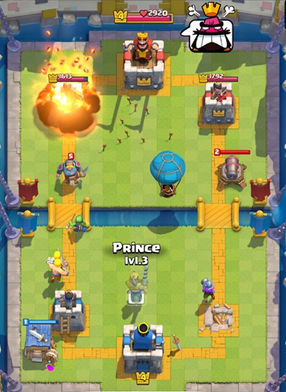

*Note: There are some details I missed like Elixir regenerates faster in a round, but you get the idea of the gameplay.
Magnificent Meta
The design at its core borrows from a lot of successful genres. It offers unlimited gameplay experiences and meta for the player. No two games will ever be the same and the player will always be experimenting with different deck combinations, card synergies and elixir curves. As more cards are released, the meta gets even more varied. This assumes Supercell balances the game so there is never a “perfect” game breaking strategy.
Tons of Progress and Goals
Clash Royale has multiple avenues of player progress, each of which lets the player progress in micro and macro steps.

 King Levels
King Levels

King Levels are a persistent representation of player progress. They are more or less, the player’s account level. Leveling up provides extra health and damage to all of the player’s starting towers in the battle field.
King Levels are earned through the collection of experience. 
 Experience is earned by three inputs (which I’ll discuss in more detail later in this article):
Experience is earned by three inputs (which I’ll discuss in more detail later in this article):
Levelling Cards
Donating Cards
Completing Achievements

 Cards
Cards

Cards are the meat of the game and the meta-game. Each Clash Royale card is randomly earned through battle, daily rewards and through store purchases. Like so many other card collecting games, they are broken down by rarity.

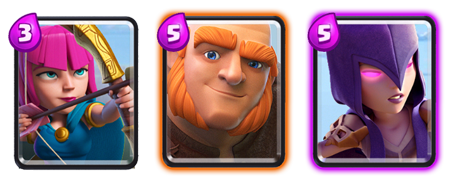
Common (White) - Rare (Orange) - Epic (Purple)
Cards are either:
Individual Troops or Squads: once placed have simple AI that takes over and march toward the enemy base to attack through the closest lane.
Each troop is balanced against each other in a Rock Paper Scissors fashion.
Troops have targeting priority (e.g. The Giant will only attack buildings).
Some troops have special traits and abilities.
Spells have special effects (freeze, damage etc.) that affect an area.
Buildings spawn troops intermittently or act as turrets.
Each card has its own sort of progression curve. As players collect duplicate cards, they can combine them using gold currency to create a levelled up version of the original. Cards are a simple enough concept, what the real genius is how they are broken apart by Trophy Arena tiers.

 Trophies and Arena Tiers
Trophies and Arena Tiers


Trophies are a fluctuating source of accomplishment. They can be won or lost, all depending on how successful a player is in combat. Trophies are used to gate access to new arenas, again adding more tiered aspirational goals for the player to achieve.


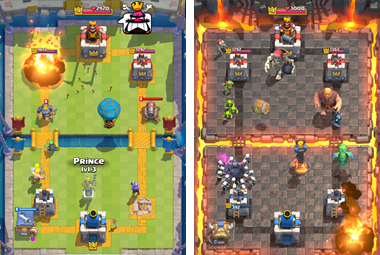
Each new arena has a new visual look and theme to keep things fresh.
Most importantly though each new arena unlocks a new pool of cards to be discovered, collected and leveled. Each newly discovered card starts at level 0, again renewing a concentric loop of unlocks and leveling goals.
 By creating a tiered unlock system, Supercell ensures there is always something new to collect and level-up. In fact the design premise works a lot like the town hall upgrades tiers from Clash of Clans. Some game mechanics are even locked based on Arena Tier to give the player more goals early on. For instance a player cannot join a clan without reaching level 3 and even the store is locked until the player has reached level 1.
By creating a tiered unlock system, Supercell ensures there is always something new to collect and level-up. In fact the design premise works a lot like the town hall upgrades tiers from Clash of Clans. Some game mechanics are even locked based on Arena Tier to give the player more goals early on. For instance a player cannot join a clan without reaching level 3 and even the store is locked until the player has reached level 1.

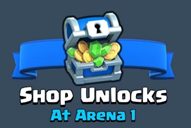
It may seem simple, but locking these staple features gives clear aspirational goals for the player to progress further and thusly will have a positive effect on retention.
Achievements
Achievements in Clash Royale follow the tried and true approach of Supercell’s other hits like Hayday and Clash of Clans.
By simply engaging in core-loop mechanics the player will earn achievements and be rewarded experience and hard currency. Early achievements are easy to complete and frequently reward the player to bolster early engagement. More difficult achievements slowly turn the hard currency tap off to create a need later on.
Achievements act as short, mid and long term goals for the player.
The most important achievement is “Team Player” and is completed by simply joining a clan. It rewards 100 gems and who wouldn pass on that? It is used to introduce the player to the social side of Clash Royale and its benefits, thusly creating longer term retention.
Everybody loves opening treasure chests…
Everyone remembers that feeling opening their first treasure chest in a game. That feeling: “Oh I can’t wait to get that chest and see what sweet loot is inside!?” Clash Royale obviously isn’t the first CCG to do this, but their presentation and pacing is fantastic.
Tons of treasure chests are rewarded early on in the new player experience and each day the player has a few chests to open right away. There are multiple types of treasure chests, each with different content and different retention strategies behind it. They are as follows:


Wooden Chests
Wooden Chests are given out as rewards for completing steps of the tutorial. The introduction of these chests do a few things:
Habitualize the player to open and to want to continue opening treasure chests.
The rapid delivery of these chests in the new player experience increases early player engagement.


Free Chests
Free Chests are literal rewards on timers. This is the evolution of “daily rewards” systems seen in every other free to play titles.
Free chests are on a 4 hour timer which encourage multiple repeat sessions per day.
Up to two chests can be stored which gives the player a buffer to open them (it is also conveniently the average length of a work day).
Free chests also can reward hard currency so act as consistent currency tap.
Free Chests almost repeat a modicum of the onboarding sensation of rapidly opening rewards every day.


Crown Chests
Crown Chests fundamentally function the same way as the Free Chests however there are a few slight differences. Crown Chests require the player to earn 10 Crowns in battles and are on a 24 hour timer.
Crown Chests are used to increase session length on a day to day basis.
They act as a full session or multisession goal for the player encouraging more retention and engagement from session to session.


Inventory Chests: Silver, Gold and Magical
Each of these chests is earned for achieving victory over another player. Unlike other chests however, these are stored into the player’s inventory and require time to open. These tasty, tasty rewards are where players will experience their first pinch moments.
Unlike other games, Game of War for example, which floods the player with instant gratification rewards; Clash Royale turns reward collection on its head. They make you wait, and waiting sucks. It builds a really powerful sense of anticipation (and retention).

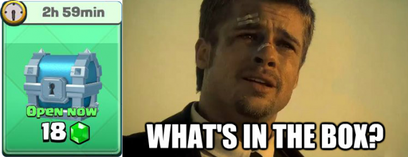
Not only that, but like I mentioned above, each chest takes a slot in the player’s inventory. Once that inventory is full, the player will not earn anymore chests.

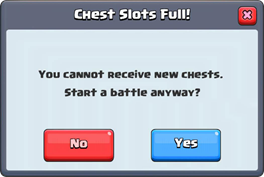
This creates a soft progression blocker. Now I say soft progression blocker because the player can still battle as much as they want. Gameplay and session length is not restricted at all. They can earn trophies and progress in Arena tiers. Players will however experience a rubber banding effect. As they progress, competition gets higher level and tougher until they are impossible to beat and the player will be forced to lose Trophies.
Without levelling cards you cannot level up, without being able to level up you will not be able to compete against tougher opponents. This means you cannot push that progression rubber band back.
The inventory chests is a simple and elegant system which does the following:
Opening a reward you earned is much more motivating of a retention mechanic than just rewards on a timer.
Encourages multiple sessions per day to open and reopen rewards on a timer.
Limited inventory encourages monetization to keep up that rewarding feeling.
Acts as a soft progression blocker for the player.
Chests of varying timers give the player a choice on how long they will be away until their next session.

 The Store
The Store

The Clash Royale store has the standard fare of purchasable goods. It has currency packs which have increased value proposition the bigger the bundle. Treasure chest purchases which skip an open timer if bought. They even have the hard currency to soft currency (gems to coins) transaction. This is all pretty standard free to play canon.


There is one thing however that I find particularly innovative on the store. That is: Cycling Card Sales.

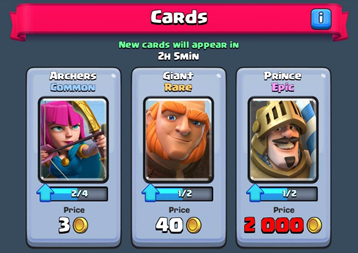
On a set timer, the store will update with 3 new cards the player can purchase for soft currency. It’s simple and works well with the games other systems. It has the main following impacts:
The timer acts as yet another retention mechanic.
The player will want to log back in to see if that card they’ve been wanting to upgrade is finally available.
The timer also acts as a monetization opportunity.
That special card they desire is finally on sale but they might not have the necessary gold. They take the opportunity to purchase gems, turn them to gold and buy it.
This becomes even more important of a feature in veteran gameplay since Epic cards cannot be obtained by any other means than chests and the store.
 Social
Social
The Clan System is a mostly direct parallel of the Clash of Clans social feature. It’s a social light system with players earning trophies by just engaging in the core loop. Trophies contribute to the overall clan score and help the group climb the clan leaderboards.
The UI and UX is vastly improved however and it appears almost like a text message feature on a smartphone. Something everyone is familiar with.

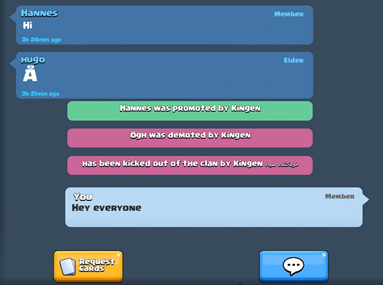
Instead of donating consumable troops ala Clash of Clans, players can donate cards to clan mates. Because cards are permanent upgrades the donation rules are more strict than Clash of Clans.
Request for Cards
.png/?width=295&auto=webp&quality=80&disable=upscale)

Players can request cards be donated to them every 8 hours. Players cannot request Epic Cards as donation. Only 1 type of card can be requested at a time.
Donating Cards

.png/?width=262&auto=webp&quality=80&disable=upscale)
Players can donate up to 2 cards per unique clan mate request. They can be either 10 common cards or 1 rare card. Players can donate up to 60 cards per day. Donated cards reward experience to contribute to the player’s King Level as well as a small token amount of gold per card (5 gold per common, 50 gold per rare).
The donation ruleset accomplishes the following:
Being part of an active social group has clear benefit for the player’s progress and has huge retention factors.
Donation request timers act as another appointment mechanic to improve retention.

 TV Royale
TV Royale

Unlike Clash of Clans, aspirational goals are a little more difficult to establish since you can’t literally just view another player’s high level base. TV Royale is a nice little feature that lets players view matches between higher level players, see their units and strategies.
TV Royale establishes that long term goal of: “I want that army and to be that awesome!” which would otherwise be missing from the product.
Awesome User Experience
From throwing down your cards to simple UI interactions, the user experience design of Clash Royale is positively sublime. A lot of iteration and user testing obviously went into making the experience as smooth and ergonomic as possible.
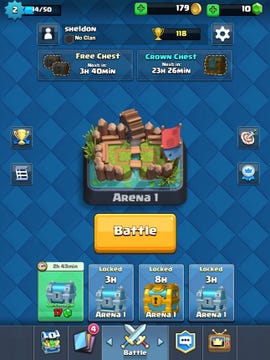

Taking some inspiration from Tinder maybe, navigating the menu is as simple as swiping left or right with smooth transitions. Icons are placed conveniently within the ideal zone for a two (or even one) finger input style.


The player’s home base, cards and deployment area are always positioned at the bottom 75% of the screen. Because of the game’s more twitch style of play, this is a very important ergonomic benchmark successfully nailed down.
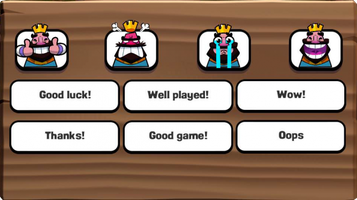

Even in-combat player communication is limited and has taken a big queue from Hearthstone. Players can only communicate using amusing emotes or a prefixed menu of verbal choices. The result is a much less toxic community and much more pleasurable gameplay experience.
What’s in store for the future?
Now we’re nearing the end of this analysis and I just wanted to leave you with my thoughts on what we might see in future versions of Clash Royale. I suspect there will be a lot of developments and quality of life features that get introduced. So here’s what I suspect to see in the near-ish future:

 New cards and New Arena Tiers
New cards and New Arena Tiers

This is obviously a given. New cards and tiered unlocks offer a lot of bang for buck in the late game meta and create new veteran player goals.
 Vanity Features
Vanity Features
Either through custom emotes or building skins, vanity features could get a lot of traction.
 Permanent Upgrades
Permanent Upgrades
Increased chest inventory or additional chest opening queue upgrades. These obviously would affect long term progression curves so would be priced accordingly.
 Multiple Deck Saving
Multiple Deck Saving
Even though modifying a deck of 8 cards is easy, simple swapping for a deck with a completely different strategy would be a nice quality of life feature.
 Limited Time Events or Arenas
Limited Time Events or Arenas
This unlikely and might be my level designer side talking, but I see opportunity to expand the arena itself as a mechanic. Adding intermittent or timed hazards to the arena could add an entirely new dimension to the gameplay experience.
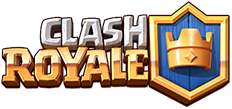

Clash Royale: Victory or Defeat?
Clash Royale hits the proverbial nail on the head when it comes to scalability and fundamentals of design. They have taken many traditional but still relevant systems, tied them together with new gameplay and added a progressive monetization strategy.
From a systems design perspective, almost every feature outside of combat exists as layered set of appointment mechanics. Retention was obviously a big goal for this product.
Reward distribution is a little too punishing with a completely hard stop from the chest inventory. Looking at games like Hearthstone, the player still earns 10 gold for every 3 games the player wins. I feel that it’s a better approach than completely flat-lining rewards like Clash Royale.
Will Clash Royale be as big as Clash of Clans? Absolutely not. But Supercell has successfully created a fun and engaging gameplay experience while establishing systems that genuinely work to aggressively retain their players.
All of this of course was just my humble opinion. I hope you enjoyed what I believe was both an informative and relatively exhaustive breakdown of Clash Royale. So what do you think? Is Clash Royale destined for a 3 crown victory or doomed to defeat?
Twitter: @Slafram
LinkedIn: http://www.linkedin.com/in/sheldonlaframboise
Site: freetoplay.ca
Read more about:
Featured BlogsAbout the Author(s)
You May Also Like







.jpeg?width=700&auto=webp&quality=80&disable=upscale)








